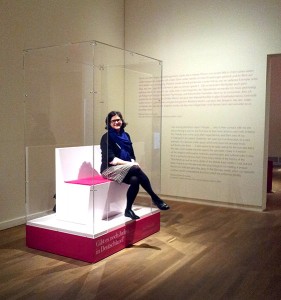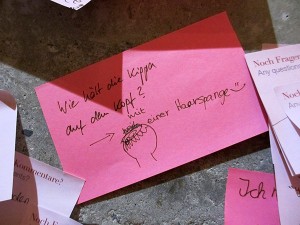My Two Hours as a Living Exhibition Object in the Show “The Whole Truth“
This was a truly extraordinary experience. The best moments were when the visitors started talking not just to me but to each other, and we wound up talking about Wagner and the weather rather than ‘just’ about growing up Jewish – or, more specifically, in my case as the daughter of a Jewish-American mother and a German, (formerly) Protestant father – in Germany and how odd it was to be sitting in a glass showcase in an exhibition.

Signe Rossbach in the exhibition “The Whole Truth”, April 8, 2013
© Jewish Museum Berlin, photo: Michal Friedlander
I was reminded of the moment in 1998 when I returned to Germany from the U.S. (although I did not want to see it that way at the time). The German publisher I was working for in New York had just been appointed State Minister of Culture by Gerhard Schröder, and I continued working for him in the Federal Chancellery, first in Bonn, then in Berlin. Back in New York, an editor at Henry Holt said to me: “Well, well, isn’t that a great job for a good little Jewish girl, working in the German government?” I thought about it, and said: “Exactly.”
So, I guess this was what brought me to sit in a glass showcase in a show at the Jewish Museum Berlin, where I have been working for twelve years now, on a seemingly quiet Monday afternoon. In my two hours of being a living exhibition object, I … → continue reading
With a flip of a wrist, showcases turn arbitrary objects into works of art. Now, I can find out what it will do to a human being. I am sitting in a transparent case which is part of the current special exhibition “The Whole Truth… everything you always wanted to know about Jews.” The visitors pass by, and we observe each other. Many read the text on the wall, throw me a look and hurry away.

Olga Mannheimer as a guest in the “Whole Truth” exhibition
© photo: Ernst Fesseler, Jewish Museum Berlin
Some stop, but keep a safe distance. I clear my throat, smile invitingly, and motion to the button on my blouse: “Ask me, I’m Jewish.” I qualified for this position, as I learned from a speech at the opening of the exhibition, by claiming to be able to tell the “whole truth” about Jews. Will anyone ask me to? The distance gradually shortens. One man wants to know what the object label on the case-window says – he does not have his reading-glasses with him. “Species: Diaspora Jew, Sub-species: Eastern European Jew, Variant: Banana Jew.” Thank you, says the man, and leaves quickly. “Banana Jew? Never heard of it,” says a woman. That was the term for Jews in Poland, I explain, who received citrus fruits and bananas from their relatives in the West.
Hesitantly, more people join the bystanders in front of my showcase. “Are you allowed to bring flowers to a seder?” “Can you sew a foreskin back on?” → continue reading
“How does a kippah stay on?”
Our current special exhibition “The Whole Truth… everything you always wanted to know about Jews” is based on 30 questions posed to the Jewish Museum Berlin or its staff over the past few years. In the exhibition, visitors have their own opportunity to ask questions or to leave comments on post-it notes. Some of these questions will be answered here in our blog. This month’s question is: “How does a kippah stay on?”

“How does a kippah stay on?”
© photo: Anina Falasca, Jewish Museum Berlin
If a non-Jew tries on a kippah, it usually falls off. This isn’t fair, but let’s examine the circumstances more closely. When tourists visit the Jewish cemetery in Prague, all men are asked to wear a kippah. Those who travel kippah-free are requested to don a blue, sharply-creased, circular piece of paper. The precarious kippah is inevitably subjected to the winds off the Vltava and flutters away. Comparably, a non-Jewish man attending a synagogue ceremony such as a marriage or Bar Mitzvah, will usually be requested to wear a kippah. Here, a stiff yet slippery synthetic satin kippah is ubiquitous. No guest stands a chance.
What then is the secret to making a kippah stay on? → continue reading


